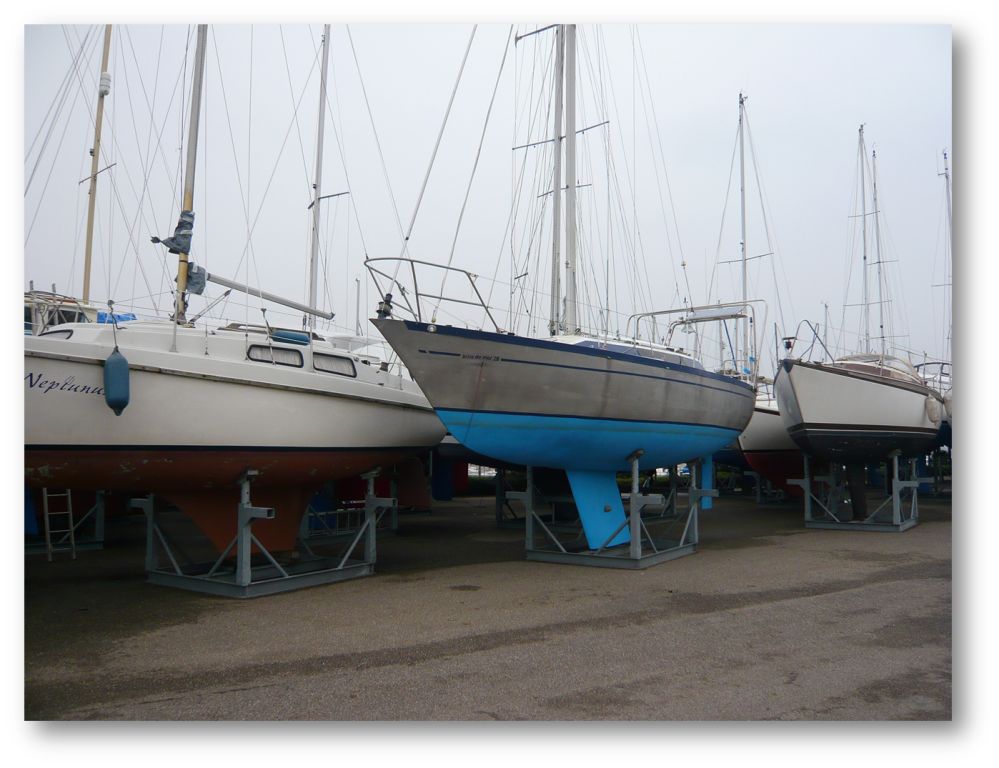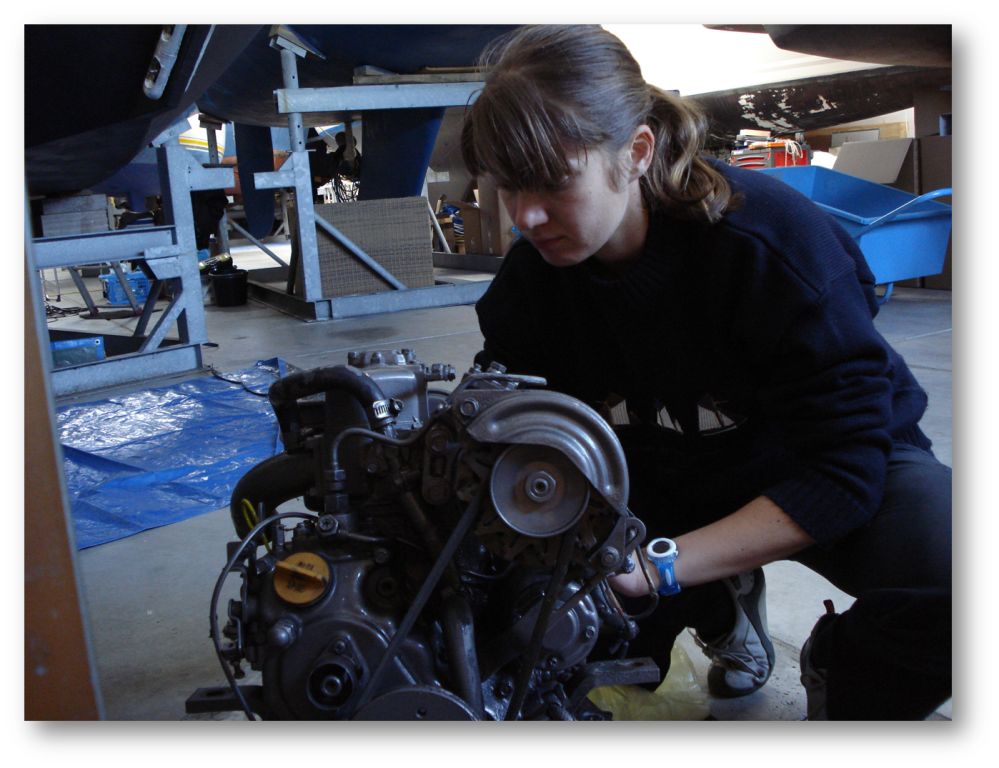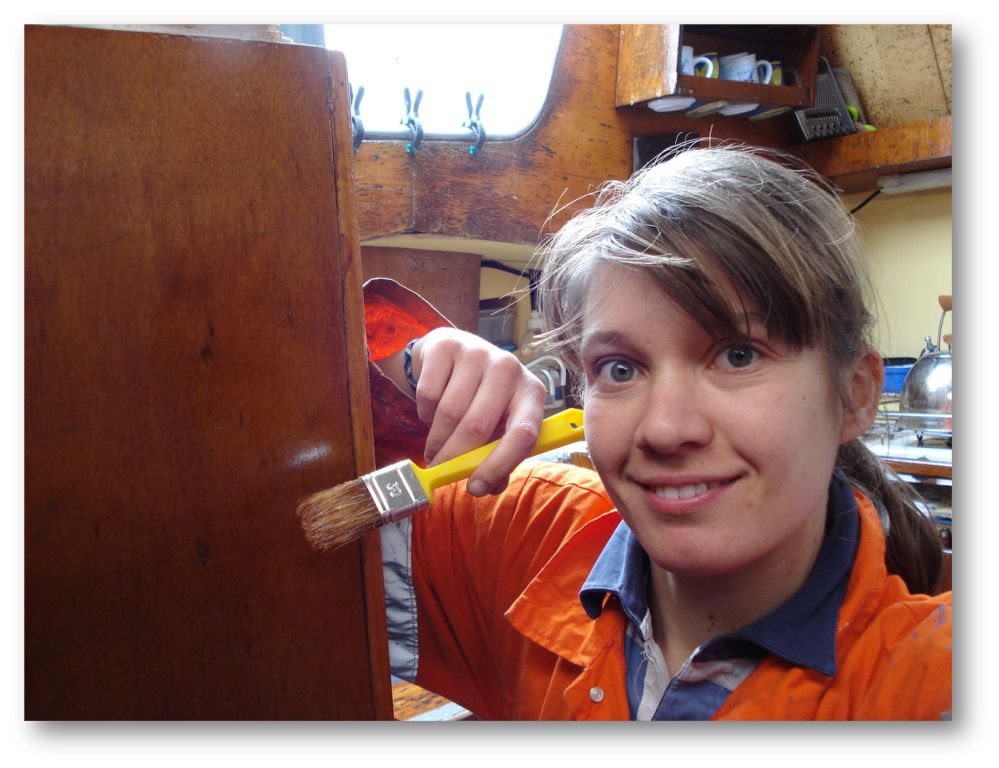| |
| |
| -- October 2010 to end of March 2011 -- |
| |
|
Last winter, last jobs, last run, the few last months before departure are all but quiet. Us being definitively engineers, we plan everything with Excel: work list, budget, planning, list of equipment to buy, paperwork and organization, each tab's got its finality so that we won't forget anything. We also try to make the most of our last months onshore while preparing everything on the background.
We must deal with various topics:
- Maintenance of the boat
- Spare parts
- Health
- Paperwork
|
| |
|
|
|
This winter again we got Saltimbanque out of the water, as it freezes up here! Indeed we Bretons are not really used to that...
We got the boat out of the water in October and stored it on the harbor car park, with all the other ones.
This allows us to work serenely on the engine for instance, even though the cold and wet weather would have us much frustrated. Many times we had to break the ice inside the hull, and remove the snow off the cockpit with a bailer, which is actually really efficient for such an unusual job! Painting jobs are getting late as the temperature would not reach the necessary 5 degrees from mid November to mid March...
|

The boat will spend the winter onshore, under the snow.
|
|
During the autumn we make the most of the last sun rays to get the equipment off Saltimbanque and carry out some slight painting jobs, and then we let him alone to enjoy the Christmas holidays with our families.
January 2011 :
The weather is wet and cold, probably the outmost ugly conditions to work on the boat.
|
|

Saltimbanque on its winter berth, on the harbour's car park.
|
Camille took the life raft off for the 3-year revision. It can look easy, but actually carrying alone a 40kgs box from deep inside the boat to the ground gets your really warmer!!! I apologize for not having taken pictures at the same time.
It's also time to have our sails check. We try to benchmark the local suppliers and Laure uses her nicest Dutch to call all the sail makers in the neibourghhood. The first one to answer worked for a long time in La Rochelle and speaks perfectly French. We really appreciate it as our Dutch dictionnary does not encompass all the technical sailing vocabulary. So this guys got the job, and Camille has spent 2 hours in his workshop to check every single point to repair.
|
|
We also spend much time in nice and warm home, to look for information, install different programs on our computer, gather some nautical charts and guides, code the web site etc.
February 2011 :
It is still way too cold to paint, but the snow and the rain have at last decided to calm down slightly. Let's go for the big jobs then!
|
|
|
The harbor master got the engine out for us at the beginning of February. Laure benefit from the easy access to dismantle the sea water valve which is not so waterproof any more since 2009, and that we had repaired with silicone mastic. As it is so easy to remove it, we are comforted in our choice to completely renew it.
|

Access is much easier without the engine!
|
|

Engine maintenance has never been so easy!
|
Camille took the warm option to take care of the engine, under the relative shelter of the workshop. Changing the oil in the gear box which is usually of very hard access is done in a few minutes. How nice to be able to turn freely around the engine, spot any small oil leak, scratch the rusty points, paint the block and do the routine maintenance operations!
|
|
|
We also work at improving the general water tightness of the boat, as too much water managed to leak in during the heavy rains of the winter.
|
|

Laure takes care of the cockpit coffer's joint...
|

...and Camille has the cabin window.
|
|
|
Last job of the month, changing the batteries. We replace the old and damaged ones by 3 new 50 Ah batteries, all of the same type to avoid that one gets discharged into another one. New plugs, nicely tightened and greased, and here we go! Ready to store all the energy that the sun will accept to give us!
|
|

Camille takes care of the 2 starboard batteries...
|

...and Laure the port's one, a bit more difficult to access!
|
|
March 2011 :
Yepee, spring comes at last! We did not dare to believe it, but the sun finally shows up, temperature reaches 15° in the afternoon, the flowers start growing up... It is thus the perfect moment for Laure to... take a one-week holiday skiing!
But while she rushes down the wet slopes simply wearing a T-shirt, Camille is happy to start painting again.
After a light polishing / cleaning, the hull receives its first antifouling paint layer where the water gets turbulent, and thus erodes the paint more rapidly: water line, keel, rudder, bow, stern, and many patches here and there. The hull looks like a Smurf Dalmatian for a while.
|
|

First antifouling layer...
|

...which transforms the hull in a blue patchwork.
|
|
|
Being alone I can freely get everything up and down inside to varnish all the wooden bulkheads and furniture, even those well hidden behind the bunks or deep in the cabins. It's quite a long job, but rather enjoyable with music playing inside the cabin, which becomes nice and bright as my job keeps progressing.
|
|

Operation varnish, overalls are necessary as everything gets sticky.
|

But the cabin suddenly becomes much nicer!
|
|
|
Outside also, wooden parts are sanded and then treated with special oil which should protect them efficiently according to Laure's father. Anyway the contact with the helm is much smoother! The row and entrance door are still being varnished though.
|
|

Sanding the helm
|

Varnishing the entrance door
|
|
|
The week-end finishes with a few small jobs: cleaning the winches, check the spinnaker sleeve that we would like to try one day, and a tentative to strengthen the guarding poles with epoxy paste, which does not seem to work so well actually...
|
|
The following week-end arrives, Laure is still skiing and here it's raining cats and dogs here... Brrrr Camille gets the sails back from the repair shop and brings them back onboard, trying not to have them wet, nor falling down the ladder! Finally for the biggest ones, I need to hoist them from the top with a halyard but without dropping them on the ground which is covered by 5mm of water, that's quite a technical job...
A little painting to warm up and here is how the kitchen now looks like!
|

The kitchen after sanding, cleaning and painting!
|
|
|
Fortunately the weather gets much better on the day after and I can paint the second and last antifouling layer. The result looks very nice, especially when remembering the unbelievable speeds we were doing last year in May with a clean hull (7 knots for 10 hours in a row in the North Sea!!)
|
|

In such moments you really appreciate to have a small boat!
|

And that's the job done! Normally this paint is going to see many miles...
|
|
|
We still have time for a few extra jobs at the end of March.
|
|
We get the starboard roof winch off to clean the aluminum under and re-do the electric isolation between the winch and the hull: we always insert plastic between fittings and the aluminum hull to avoid electric corrosion between the two materials.
We also link air pipes from aeration grids in the cockpit to the engine room, to bring fresh air down there. We'll have to remember to seal off these aerations during bad weather as the last thing we want is that water gets in the pipe and drowns the engine off!
|

Laure prepares the aluminum under the winch, before recovering it with epoxy paint.
|
|
|
We desperately look for activity, but actually it really seems like everything is ready for Saltimbanque to be put back in the water! Indeed we are still missing a propeller shaft and a sea water valve, but they should be ready by Friday April 1st...
|
|
| |
| |
| TOP
|
| |
|
|
The question of spare parts is always touchy, especially onboard a small boat: should we double every single part, but then how can we store everything in our 6m x 2m living space? Just a spare main sail salt is tricky to store.
Our approach is to be self-sufficient while sailing may a critical part happen to break, but to work it out locally for the nice-to-have. So we did an assessment of everything we absolutely need at sea, and established the following list of spare parts to take in addition of the normal inventory. Of course they need to come with a coherent tool box!
Rigging: one long type and one short type cable, stainless steel axes (that we'll get in Brittany)
Sails: : spare slats, a complete repair & sewing kit, sliders for forced slats, basic sliders
Energy: power unit for the solar panel, generator belt, gas pipe and valve
Navigation: hand VHF and GPS in addition to the fix ones, stored in the survival box, hand echo sounder, transparent paper, color pens and paper to copy charts
Engine: 2 cartridges for each type of filter, 3 water pump impellers, 2 anodes, 2 gaskets, pipe for diesel, banjo connectors and their copper joint, additive for the diesel, oil, paper for joints, paste for joints, sparking plug for the over-board engine, and some "rescue-tape" which does not melt in diesel !
Wind pilot: Unfortunately not much, as Plastimo does not manufacture this model any more. By chance we already have a few small parts in spare.
Chandlery: shackles, Dyneema shackles, pulleys and ropes of several kinds
Winches : spare kits for the different types of winches onboard, grease
Miscellaneous parts: several kinds of tape, silicone tubes, glue, sika, small ropes, Dyneema, WD40, electric wire, electric terminals, iron wire etc.
Cameras: yes yes it is critical! We will leave with 2 cameras, ours which follows us everywhere since more than 3 years, and a waterproof one for under-water pictures.
|
|
|
A good list of spare parts can also be found in the very good book of Antoine: "Mettre les voiles" (for French speaking people only, who should rather read this site in French by the way!)
|

|
|
| TOP
|
| |
|
|
|
Health question during a 1 year trip is not something to be improved to our opinion. So we get prepare actively in this domain too.
|
|
Before meeting our doctors for a check-up and get prescriptions for the necessary medicines, we have chosen to participate to a dedicated training: "Medicine in isolated areas." This 2-day training is organized in Paris by the IEFS (European Institute for Health Training) via a sailing association: Sail The World (www.stw.fr). It's then perfectly tailored for long distance sailors.
We learnt many things, such as making diagnoses, what medicines to bring with us, emergency numbers, and also we got trained to stitches, injections, and most of all how to wash your hands !!
|

This is a pig foot about to be stitched...(thanks Philippe for the picture!)
|
|
Thanks to this training we can build our pharmacy and are thinking about a new locker to store this bulky equipment.
For your information, here is a summary of what we take. This list only engages ourselves and shall never replace the professional list that you would establish with your doctor.
Anti-allergies: antihistaminiques (Clarétyne & Kestin), ventoline, cortisone cream, 2 adrenaline pen in case of anaphylactic shock.
Pain killers: paracetamol, anti-inflammatory, paracetamol with codeïne, muscle relaxant, aspirin (used especially to make blood more fluid)
Antibiotics: there are 4 main types: amoxiciline, pristinamycine, ofloxacine and metronidazole, each one being specialized for a certain infection (bones, digestive system, illnesses etc.). We'll bring one full treatment of each type at least. We will also take the "atomic bomb" of antibiotics as our trainer said, which needs to be injected, in case of very serious illness (meningitis, generalized infection etc.) Of course these medicines are not harmless and require a medical opinion before taking any of them. (the maritime medic center in Toulouse is specialized to these situations)
Burns treatment: : cooling gel (very useful on a boat like ours without any cooling means), cream and dressings.
Wounds: 3 stitches kits, local anesthetic kits, betadine, hexomedine, alcohol 70°, hydrogen peroxyde, hydro-alcoholic soap, sterile gloves, powder, dressings
Digestive problems: imodium, smecta
Malaria: malarone, mosquito repellant, (we will impregnate our mosquito nets before leaving)
Traumas: cooling bags, elasto for straps, band, the splints we already have (knee, ankles), anti-inflammatory cream
|
|

|
All this coming with the notes that we took during the training, and the book "Medecine de Voyage" which is nicely illustrated with drawings rather than pictures. We are not that much "cowards", but still we would not consider reading a book to maintain our knowledge level if half a finger can be found on page 32 and the remaining part page 34!!
|
|
| TOP
|
| |
|
|
|
Paperwork to be done when preparing a year off can be quite heavy, especially when back from a foreign country. As a general rule, you do not fit in the boxes any more, and everything that you manage to do under normal conditions quickly becomes a nightmare...
|
|
|
Work: Work: There are different possible ways to leave, from regular paid holidays to pure resignation. We have benefited from the understanding of our companies who let us leave for unpaid leaves for the duration of our choice. So we'll get no income, no rent nor health coverage, but the certitude to have a job with the same kind of salary when we come back. We have been quite lucky on that side...
|

"Dear sir, I'm Achille Talon, and I have the project to..."
"Is it profitable?"
Well, how to tell you...
|
|

The 12 jobs of the long distance sailors...
|
Taxes and address matters: We have chosen to keep an address in France (thanks to our parents!), so that our official mails are regularly open. The French tax office now allows us to declare and pay online, but only if you fit in the regular boxes (see above). Most probably you will have to fill in paper forms during your leave. It is good to leave a pre-filled paper form to someone that you can trust. We'll also write a letter to explain the tax office why suddenly we do not make money any more. And delegations for the mail, bank, elections, taxes etc. Anyway it will be a mess!
|
|
Cars: We have chosen to keep an old car during our trip, so that we have transportation means when back in France. But then you have to pay for the insurance.
Insurance: We have a third party insurance for Saltimbanque, which gives liability insurance to the whole crew, as well as repatriation insurance. We do not pay much for it but it only covers damages done to others. Damage on Saltimbanque will be fully charged to us, up to us to be cautious!
Health insurance: It was outof question for us to leave without a proper health coverage. As Camille will keep a working contract until mid-August (thanks to many holidays patiently spared...), we will keep the company insurance until this date. Afterwards we will pay for our own insurance (about 600 euros per person)
Money: We'll tell you as we go along how we manage the money, of course we have been sparing for several years to have the means to leave autonomously during this year. Most countries visited accept credit cards, so we won't bring much cash. However we'll leave with several credit cards (visa and mastercard gold) allowing us to withdraw much cash if necessary. For the day to day, we plan to open a dedicated account that we will regularly feed from our personal acocunts. If this credit card gets stolen then our reserves won't be at risk!
|
|

Paperwork is exhaustingand time consuming. Unfortunately it's necessary to be able to live serenely.
|
|
|
We achieved much work and preparation during the winter. And everything is now ready to have the boat back in its natural element, water...
|
|
| TOP
|
| |
| |
| |
| |
| |
| TOP
|
| |
| |
| |
| |
|
